Why Read This Article?
Finish Nailer Repair - Replacing the Driver Guide (Ridgid Part # 79004001022)
Article Breakdown
Finish Nailer Repair - Replacing the Driver Guide (Ridgid Part # 79004001022)
Tools & Materials
- Flat-head screwdriver
- Phillps-head screwdriver
- Spark tester (for some diagnoses)
- Compression tester (for some diagnoses)
- Depending on your specific equipment, other tools may be needed.
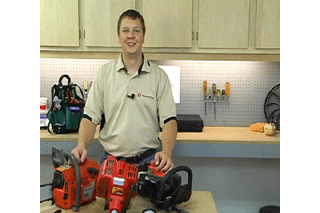
When thinking about diagnosing two-cycle engines, it's best to think about the systems that help the motor run: the fuel system, the ignition system and the compression system. When beginning to troubleshoot engine problems, it is usually best to examine each system in the order in which they are listed above since the fuel system fails before the ignition system, and the ignition system generally fails before the compression system.
For this repair we used a Shindaiwa string trimmer, a Husqvarna chainsaw and a Tanaka hedge trimmer. Before you begin a repair on these --or any other lawn equipment brand--be sure you have the right Shindaiwa, Husqvarna and Tanaka parts.
Diagnosing the Fuel System
The fuel system comprises the fuel tank, fuel lines and carburetor. Most of the problems with the fuel system will pertain to the carburetor, but you will want to be sure your fuel lines and tank are in good condition before you begin diagnosing the fuel system.
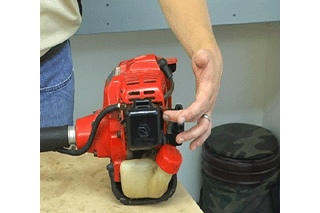
1. Remove the air system
Open the air filter cover and remove the air filter.
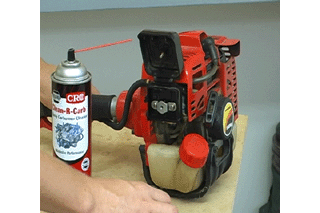
2. Spray starter fluid into the carburetor
Spray a little bit of starter fluid or carburetor cleaner directly into the air intake on the carburetor.
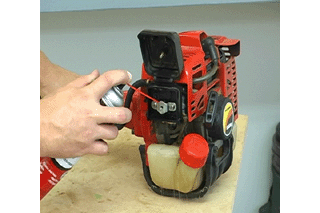
3. Pull on the starter rope
Now pull the starter rope and see if your engine starts up.
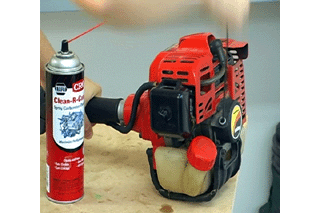
Diagnosis: If the engine fires up and immediately dies, then you probably have a problem with your carburetor. The engine starts because it can burn the fuel you just sprayed directly into the carburetor, and it dies when that fuel burns off. This means that carburetor is not properly delivering fuel to the engine. You can fix this problem by cleaning your carburetor, or if it is especially dirty or worn, rebuilding your carburetor.
[Back to Top]
Diagnosing the Ignition System
If you performed the fuel test and your tool did not start at all, you will need to troubleshoot the ignition system next. The ignition system includes the spark plug, spark plug wire and the ignition coil.
1. Remove the cover
Remove the cover on your tool (we used a Husqvarna chainsaw) to gain access to the ignition system.
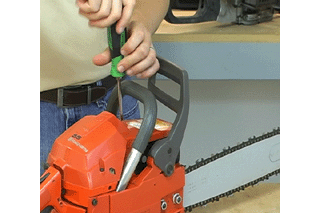
2. Replace the spark plug
If you believe you might have a problem with your spark plug, for example if you haven't replaced it in years, you will want to try a new spark plug before moving forward. Spark plugs are inexpensive and are usually to blame for ignition problems.
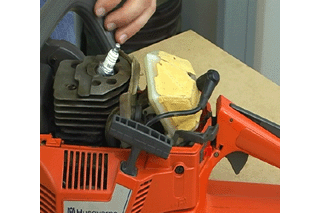
3. Test the ignition coil
To test the ignition coil, you will need a spark plug tester. Install it in-line between the spark plug wire boot and the spark plug.
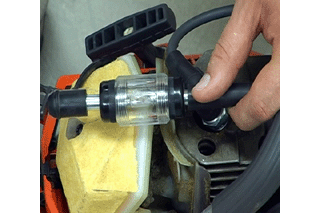
4. Pull on the starter rope
Now you can test your ignition coil by pulling the starter rope.
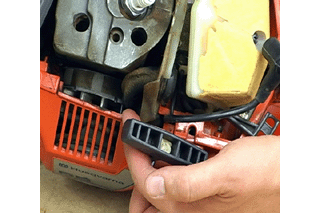
Diagnosis: If you do not see a spark in the spark tester window, you will need to replace the ignition coil in your tool. If your tool sparks but won't start, you should continue on to the compression test.
[Back to Top]
Diagnosing the Compression System
If both the spark test and the fuel test fail, you will need to try a compression test. This measures the amount of pressure in the tool's cylinder. Lawn equipment compression should fall in a range between 90 and 110 psi.
1. Remove the spark plug
Remove the spark plug from your tool.
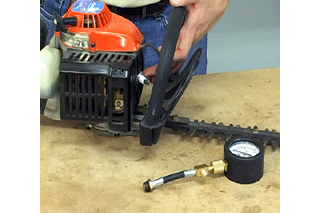
2. Install the compression tester
Install the compression tester where the spark plug would normally be. Be sure to get a good seal between the tester's o-ring and your tool.
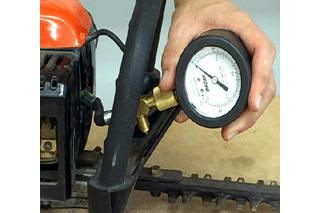
3. Pull on the starter rope
Pull the starter rope a few times to get an accurate compression reading. Normal compression is between 90 and 110 psi.
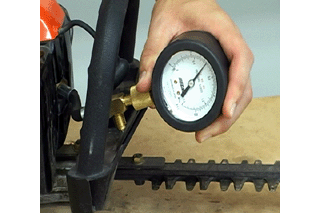
Diagnosis: A compression lower than 70 psi is indicative of some pretty serious problems. If you are lucky, you will only need to replace the piston rings. More likely, your engine registers such low compression because you have a damaged piston or cylinder. If your tool has less than 70 psi, you will most likely have to replace it.
[Back to Top]
Conclusion:
You can follow the steps in this article to quickly diagnose all your two-cycle lawn equipment. By following the steps here you can rule out the most likely problems first, saving you time and money on your repairs.
Before you begin any repair, be sure to use our convenient model number search feature to find the right parts for all your lawn equipment repair needs.
[Back to Top]
What we're about.



















































